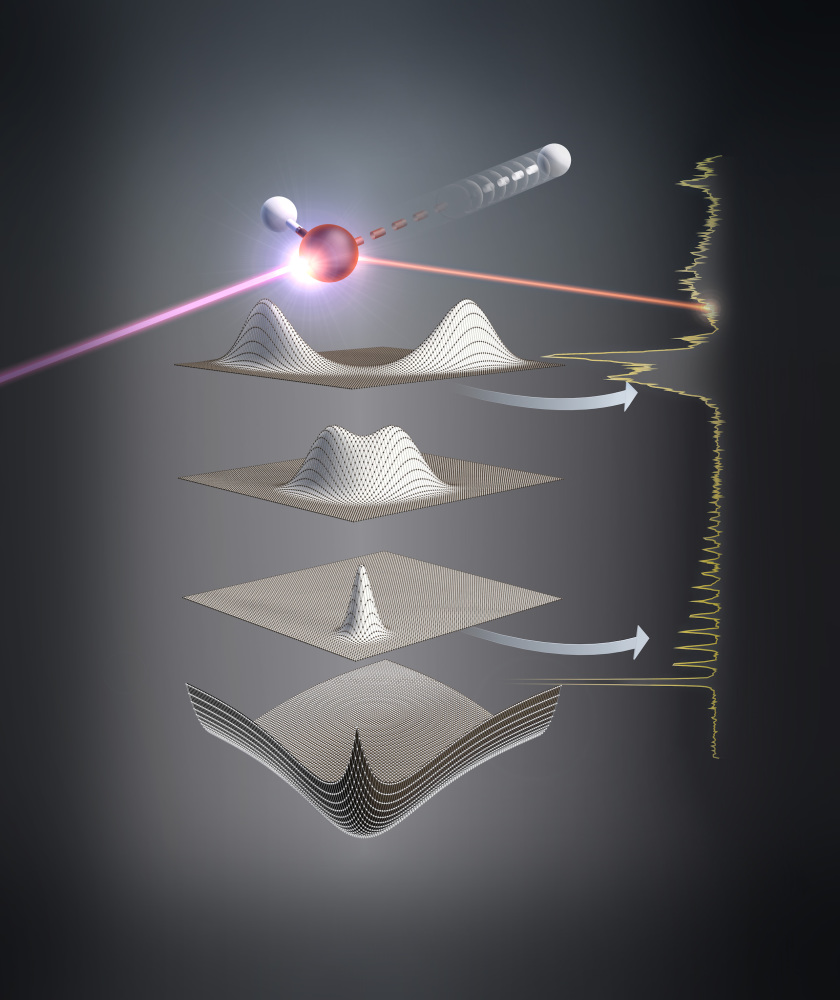Review: X-ray scattering methods with synchrotron radiation

Resonant X-ray excitation (purple) core excites the oxygen atom within a H2O molecule. This causes ultrafast proton dynamics. The electronic ground state potential surface (bottom) and the bond dynamics is captured by distinct spectral features in resonant inelastic X-ray scattering (right).
© Martin Künsting /HZB
Synchrotron light sources provide brilliant light with a focus on the X-ray region and have enormously expanded the possibilities for characterising materials. In the Reviews of Modern Physics, an international team now gives an overview of elastic and inelastic X-ray scattering processes, explains the theoretical background and sheds light on what insights these methods provide in physics, chemistry as well as bio- and energy related themes.
"X-ray scattering can be used to investigate and resolve a wide variety of issues from the properties and excitations of fuctional solids, to homogeneous and heterogeneous chemical processes and reactions or even the proton pathway during the splitting of water," explains Prof. Dr. Alexander Föhlisch, who heads the Institute Methods and Instrumentation for Research with Synchrotron Radiation at HZB.
The article gives an overview of experimental and theoretical results in the field of resonant scattering of tunable soft and hard X-rays. The focus is on resonant inelastic X-ray scattering (RIXS) and resonant Auger scattering (RAS). In the review, the authors outline the most important achievements from the last two decades at Synchrotrons up to the latest advances in time-resolved studies with X-ray free-electron lasers.
arö
https://www.helmholtz-berlin.de/pubbin/news_seite?nid=23153;sprache=en
- Copy link
-
Green fabrication of hybrid materials as highly sensitive X-ray detectors
New bismuth-based organic-inorganic hybrid materials show exceptional sensitivity and long-term stability as X-ray detectors, significantly more sensitive than commercial X-ray detectors. In addition, these materials can be produced without solvents by ball milling, a mechanochemical synthesis process that is environmentally friendly and scalable. More sensitive detectors would allow for a reduction in the radiation exposure during X-ray examinations.
-
Electrical energy storage: BAM, HZB, and HU Berlin plan joint Berlin Battery Lab
The Federal Institute for Materials Research and Testing (BAM), the Helmholtz-Zentrum Berlin (HZB), and Humboldt University of Berlin (HU Berlin) have signed a memorandum of understanding (MoU) to establish the Berlin Battery Lab. The lab will pool the expertise of the three institutions to advance the development of sustainable battery technologies. The joint research infrastructure will also be open to industry for pioneering projects in this field.
-
BESSY II: Insight into ultrafast spin processes with femtoslicing
An international team has succeeded at BESSY II for the first time to elucidate how ultrafast spin-polarised current pulses can be characterised by measuring the ultrafast demagnetisation in a magnetic layer system within the first hundreds of femtoseconds. The findings are useful for the development of spintronic devices that enable faster and more energy-efficient information processing and storage. The collaboration involved teams from the University of Strasbourg, HZB, Uppsala University and several other universities.
